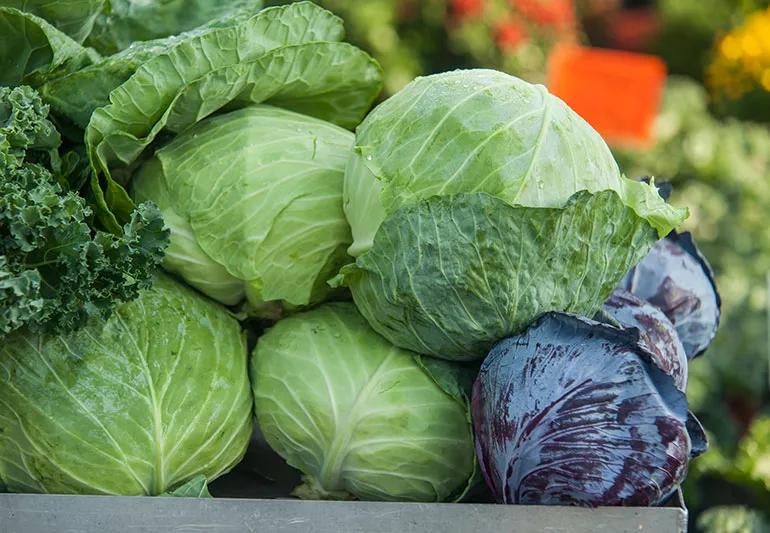This superfood comes in all shapes and sizes

Cabbage may not be the most attractive vegetable, but it’s full of nutritional goodness that can keep you feeling strong and healthy. From boosting your immune system to improving your digestion (sometimes with embarrassing results), cabbage and its health benefits deserve a place at your table.
Advertisement
Cleveland Clinic is a non-profit academic medical center. Advertising on our site helps support our mission. We do not endorse non-Cleveland Clinic products or services. Policy
This common leafy green vegetable comes in a range of colors, shapes and sizes that you can use for soups, salads, sandwiches and more. Eat it raw or stir-fried to get the most benefit. Find it fermented in gut-healthy foods like sauerkraut and kimchi — or chopped into coleslaw for a quick fix.
“Cabbage is good for you. It’s one of those foods that tastes better than it looks, and it has even more nutritional value than people expect,” says registered dietitian Julia Zumpano, RD, LD. “Plus, it’s versatile, affordable and easy to find.”
Zumpano explores the benefits of eating cabbage and how it can boost your health.
Many people recognize cabbage for its bounty of fiber, vitamins and minerals. One cup of chopped, raw green cabbage is only 22 calories and delivers:
“Cabbage is also a potassium-rich food, which can help lower high blood pressure,” says Zumpano. “The more we learn about cabbage, the better it promises to be.”
Research shows leafy green vegetables, in general, are good for you, but we need more studies to understand how cabbage specifically affects your body. Zumpano says many people believe the nutritional value of cabbage means it can have any of the following benefits.
Advertisement
Some of cabbage’s health benefits are due to anthocyanins, which are naturally occurring antioxidants. Anthocyanins not only add color to your fruits (think blueberries) and vegetables, but may also reduce inflammation.
Chronic inflammation (long-term swelling) is associated with heart disease, cancer, rheumatoid arthritis and many other medical conditions. In animal studies, anthocyanins have been shown to help control inflammation.
We need more research, but one small human study showed that those who ate the most cruciferous vegetables had much lower inflammation levels than those who ate the least.
Vitamin C, also known as ascorbic acid, does a lot of work for your body. It helps make collagen and boosts your immune system. It also helps your body absorb iron from plant-based foods.
Packed with phytosterols (plant sterols) and insoluble fiber, cabbage can help keep your digestive system healthy and bowel movements regular. It fuels the good bacteria in your gut that protects your immune system and produces essential nutrients. That’s especially true when you eat fermented cabbage in kimchi or sauerkraut.
“Cabbage can help you stay regular,” says Zumpano. “It can also help support safe and healthy weight loss.”
Fiber is a nondigestible or absorbed carbohydrate, so it adds bulk to meals and takes space in your belly causing you to fill full faster and longer without ingesting carbs that you’re absorbing.
The anthocyanins found in cabbage help with more than inflammation. Research suggests they add to the health benefits of cabbage by reducing your risk of heart disease. Scientists have found 36 different kinds of anthocyanins in cabbage, which could make it an excellent option for cardiovascular health.
Potassium is a mineral and electrolyte that helps your body control blood pressure. One cup of red cabbage can deliver a healthy amount of potassium — as much as 6% of your recommended daily value. This could help lower your blood pressure, reducing your risk for heart disease.
Too much “bad” cholesterol, or LDL cholesterol, can cause heart problems if it builds up in your arteries. Cabbage contains two substances — fiber and phytosterols (plant sterols) — that compete with cholesterol to be absorbed by your digestive system. They wind up reducing your bad cholesterol levels and improving your health.
Vitamin K is essential to your well-being. Without it, you’d be at risk of developing bone conditions like osteoporosis, and your blood wouldn’t be able to clot properly. Enter cabbage, a great source of vitamin K. One cup provides 85% of the recommended daily value.
Advertisement
“Vitamin K helps keep our bones strong and our blood clotting well,” says Zumpano. “Cabbage can give you that boost you need to make sure your levels are adequate, and your body stays protected against illness and disease. And you don’t even need to eat that much cabbage to get great health benefits.”
Early animal studies suggest that leafy green vegetables like cabbage have phytochemicals that may help protect against cancer. They contain antioxidants and plant compounds like glucosinolates. These sulfur-containing chemicals break down during the digestive process into substances that may help fight cancer cells and clear them from your body.
Excited to add more cabbage to your diet? Just be careful not to go overboard. To maximize its health benefits, increase your cabbage intake slowly and allow your body to adjust. Also, stay hydrated to reduce constipation, which can cause excess gas.
Cabbage might not be the best choice for a romantic night out since eating too much can cause diarrhea, flatulence or abdominal discomfort. It also contains substances that can interfere with medications like blood thinners or cause hypothyroidism, a condition where your thyroid doesn’t create enough thyroid hormone and causes your metabolism to slow down.
Advertisement
In most cases, you can avoid side effects by eating cabbage as part of a healthy diet. Talk to your healthcare provider if you experience symptoms or have any concerns.
Cabbage belongs to the Brassica oleracea species of vegetable, along with broccoli, cauliflower, kale and Brussels sprouts. The most common type is green cabbage. But hundreds of other varieties exist in red, white and purple hues, with a range of textures and sizes.
Some forms of cabbage have subtle, delicate flavors, while others pack a peppery punch. Nutrition from cabbage comes from types like:
Advertisement
Cabbage is a versatile vegetable that’s affordable, widely available and easy to prepare. Keep it whole and unwashed in the refrigerator until you’re ready to eat it, recommends Zumpano. And when you’re ready, it won’t take long to find easy cabbage recipes that add a (healthy) zing to your diet and color to your plate.
Learn more about our editorial process.
Advertisement

This root veggie can also benefit your gut, heart and eyes

As the stalky vegetable breaks down, it leaves behind sulfuric byproducts that can make your pee stink

Most of the time, beeturia is a curiosity, not a concern

This cruciferous veggie boosts your bone, eye and heart health and contributes to a lower risk of cancer

Some diets shun them, but research hasn’t concluded that they’re harmful

This versatile type of seaweed may help support weight loss, bone health and cancer prevention

Pickles are low in fat and calories and rich in some vitamins and minerals, but they’re usually high in sodium

Lettuce is a versatile vegetable loaded with antioxidants and good-for-you nutrients

Babies can get congested easily, but you can calm their cough by keeping them hydrated, using nasal drops and running a humidifier

Weight loss may cause loose, sagging skin and muscle loss to your rear

Several conditions, like vitiligo and fungal infection, can cause a loss of pigmentation, leading to white spots or patches on your skin